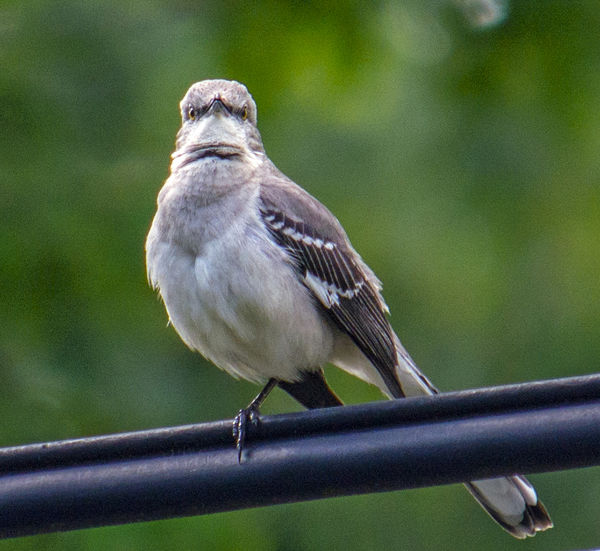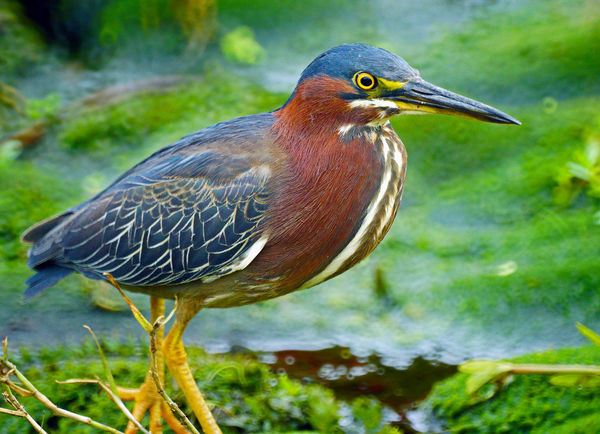Bird Photography In Overcast Conditions
Feb 2, 2019 13:30:01 #
BurghByrd wrote:
Essentially a back lit subject, high dynamic range problem. I'd start by capturing the shot in RAW format or HDR. Also, it might be instructive to spend a day experimenting using HDR, bracketing various apertures, ISO settings etc and evaluating the results for what produces what you like best. The RAW format with post processing should help in that it can pull detail from a somewhat under exposed subject. Good luck.
Do you have an example of a bird capture using HDR?
Feb 2, 2019 13:50:36 #
You might consider something like this! I tried it outdoors at night and lit up a house about a block away... It concentrates the light for using with your flash... The extender is a better beamer... It will give you enough light to stop the birds in midair at a pretty good distance... This will let you stop down and maybe give you the depth of field needed to capture the bird... Good Luck 



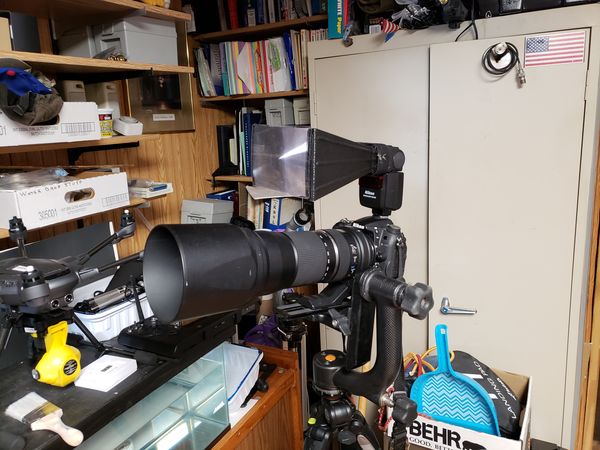
Feb 2, 2019 13:59:07 #
jeep_daddy wrote:
Taking pictures of birds with low lighting conditi... (show quote)
Are you saying that the immature night heron I posted where I used 1/10 shutter speed and no flash, exposure comp is a throwaway? Or the painted bunting where I used ISO 1600, no flash, no exposure comp, manual exposure setting, no Better Beamer etc is also a tossable image?
What happens when you use fill flash at sync speed - 1/200 or 1/250 on Nikon - and the bird moves? You don't see two images, one frozen by the flash and the other a blurred image taken at ambient light exposure settings?
Feb 2, 2019 14:16:59 #
Even birds that flit around have moments of stillness. This is where burst shooting (spray and pray) pays off. I shoot birds with a Nikon J1 with a one inch sensor and a Nikkor 55-300 AFS lens and FT-1 adapter that gives me center point autofocus with an equivalent focal length of 810mm, fairly close to the equivalent focal length of 750mm you get with your 500mm lens.
In overcast conditions, if you can get some greenery behind the bird it will highlight the bird. Overcast can be helpful in the sense you avoid deep shadows.
I would say adjust your settings for the available lighting, rather than to try to freeze the bird. The attached cropped pic was taken handheld at about 75ft. at f5.6, iso-100, 1/160th of a second.
In overcast conditions, if you can get some greenery behind the bird it will highlight the bird. Overcast can be helpful in the sense you avoid deep shadows.
I would say adjust your settings for the available lighting, rather than to try to freeze the bird. The attached cropped pic was taken handheld at about 75ft. at f5.6, iso-100, 1/160th of a second.
CHARLESTON 1979 wrote:
I live in northern Oregon. Much of the fall and winter months have overcast/rainy conditions. I use a Nikon 7500 with a 200-500mm lens. Getting the right settings for shooting birds, particularly small ones that flit around, stumps me. Suggestions for settings?
Thanks for your help.
Thanks for your help.
Feb 2, 2019 14:31:41 #
Bobspez wrote:
Even birds that flit around have moments of stilln... (show quote)
Now that's a great Mockingbird shot.
Feb 2, 2019 14:41:13 #
Feb 2, 2019 15:46:09 #
billnikon
Loc: Pennsylvania/Ohio/Florida/Maui/Oregon/Vermont
CHARLESTON 1979 wrote:
I live in northern Oregon. Much of the fall and winter months have overcast/rainy conditions. I use a Nikon 7500 with a 200-500mm lens. Getting the right settings for shooting birds, particularly small ones that flit around, stumps me. Suggestions for settings?
Thanks for your help.
Thanks for your help.
I use manual, with digital it takes only a few peeks at the screen to get the exposure right. If your shooting mirrorless you can see the final result as you adjust your settings.
OR, use aperture priority and use your exposure comp. as a final adjustment to get the exposure just right. Using aperture I like to shoot at least 1/2000 sec. on those fast little guys. I also prefer centered weighted metering.
Good luck and keep on shooting until the end.
I believe your D7500 has GROUP AUTO FOCUSING, I really like this setting.
Feb 2, 2019 17:14:59 #
Gene51 wrote:
Do you have an example of a bird capture using HDR?
This was not HDR, but it was a 6 exposure noise reduction (JPEG only) done on a Sony A77II .....with the 500 AF REFLEX mirror lens .....
..
Feb 2, 2019 17:27:00 #
CHARLESTON 1979 wrote:
I live in northern Oregon. Much of the fall and winter months have overcast/rainy conditions. I use a Nikon 7500 with a 200-500mm lens. Getting the right settings for shooting birds, particularly small ones that flit around, stumps me. Suggestions for settings?
Thanks for your help.
Thanks for your help.
I assume you've already set auto-ISO. This is one of thoes few situations
where it is justified.
You didn't whether you are at home or in the field, so I'll cover both.
In either case, scattering some food (if legal) will make it more likely
the birds slow down. If you want to avoid "bird at feeder", then don't
use a feeder -- put some suet or seeds on a tree limb.
If the birds refuse to stand still, then you're probably going to have to shoot
shutter priority mode, with the longest shutter speed that gives you acceptably
small motion blur. Can't say what speed that its, because it depends on how
fast and at what angle the birds are moving, the distance, and how much blur
you find acceptable.
If you are photographing around you house and happen to a yard light,
put a high-wattage bulb in it and turn it on. It might help a little.
Or if you have a motion-detector flood light on our house, rig it so it
stays on (some will if you flick the swtich twice rapidly).
If you own a really powerful flash, then fill flash might help.
I don't shoot birds (not with a camera, anyway) but I do shoot in low light,
so I can sympathize. I'm afraid you're going to have to make the best
of a bad lighting situation: overcast + telephoto zoom lens + moving subject.
You may not be able to take the kind of photo you usually take.
A lot depend on how thick the overcast is.
First, spot meter everything -- bird, background, sky, snow on ground, so
you really know what you're facing. If an exposure less then 1/60th
impossible, go inside and have a hot toddy. No photographer can get every
shot except a bad one.
Consider a 200 mm f/4 prime lens (more expensive than it ought to be,
and limits your range). Or put on your fastest prime lens and
sit in your parked car near the bird feeder (works best if the car has
tinted windows, so the birds can't see you).
Finally, consider if maybe a little motion of blur of wings looks OK--
it gives a sense of speed. We see zillions of BPB ("bird plus bokah")
photos that look like stop-motion flash: everything crystal sharp.
Maybe that's not the only way to photograph a bird?
Or maybe you photograph a flock of birds? Behavior is always more
interesting, and many birds are social.
When all is said and done, photography depends as much on "situational
awareness" (as the military says), improvization and visualization as it
does on camera settings.
Feb 2, 2019 17:45:25 #
imagemeister wrote:
You could use a Rogue Safari light condenser for the pop-up flash. Otherwise, using a bodypod or monopod would help allow getting your shutter speed down.
The Rogue Safari is a mini-Beamer FWIW .....works @f5.6 out to 60 feet .....
..
Feb 2, 2019 17:55:41 #
Your setup would look like Larryzplace above with the flash extender. Including the Gimbal head on the tripod too. You already have a good camera and lens. I would read your manual for exposure techniques (e.g. Auto ISO on manual) and for autofocus modes and zones for your camera, very important. Nikon Speedlight Flashes are great at fill light. I would suggest -1 2/3. And they can work at high shutter speeds such as 1/500 sec or faster. After that put yourself in front of some great subjects knowing their habits. And in a year or so of shooting you will be bagging winners. That's all there is to it.
BebuLamar wrote:
Now I don't know how to do Auto ISO and flash or fill flash. I don't have a TTL flash. Can you show us how?
Feb 2, 2019 18:18:51 #
IMHO if you are shooting at home you should always use a feeder, two at most. Then place snags/branches near the feeder. The birds will get used to landing on the branch before jumping onto the feeder. If you make the feeder portable you can change the background by moving it just a few feet. I posted what I use at home a few years ago:
https://www.uglyhedgehog.com/t-367004-1.html
I also have a small version on a small tripod that I used to use a lot at an NWR on Long Island. Since we weren't spreading anything (although the birds did) the rangers had no problem.
--
https://www.uglyhedgehog.com/t-367004-1.html
I also have a small version on a small tripod that I used to use a lot at an NWR on Long Island. Since we weren't spreading anything (although the birds did) the rangers had no problem.
--
Feb 2, 2019 20:03:59 #
Oh yes. You have to know a few tricks about feed, perches, backgrounds, and so on.
Bill_de wrote:
IMHO if you are shooting at home you should always... (show quote)
Feb 2, 2019 23:01:20 #
imagemeister wrote:
This was not HDR, but it was a 6 exposure noise reduction (JPEG only) done on a Sony A77II .....with the 500 AF REFLEX mirror lens .....
..
..
That explains the weird bokeh. But the heron is nice and sharp.
Feb 4, 2019 16:06:54 #
Gene51 wrote:
Are you saying that the immature night heron I pos... (show quote)
First off, I was replying to CHARLESTON 1979 and trying to help him with my opinions. I've never seen, or don't really remember seeing any of your images or examined any of the EXIF data of your images so I can't really comment on which ones are or are NOT keepers. Using a 1/10 shutter is extremely difficult to do at the long zooms such at 400mm and up. I don't know what your focal length was for your Night Heron or how the lighting conditions were. If you were happy with that image, and you used a 1/10 shutter then that's great. I've got some shot at 1/6 shutter that I've kept. But if you read what I was saying, I said "most" are not keepers at such slow shutters. I didn't say all. When I have really low lighting conditions like I've talked about, I try to steady my camera on something, and use burst mode. Maybe one in 20 will be sharp. Or I use a tripod. But hand held will not be very easy to get ANY keepers. Although, you can get lucky and get some that are. It also depends on your experience, skill and technique. Not likely that a beginner that is asking this question that the OP is asking is going to net great results for some time using a really slow shutter speed like 1/10th.
To answer your question about flash at 1/200 or 1/250th (sync speed of Nikon and most other cameras for that matter) will NOT give you a double exposure. You should give it a try. I'm not saying that using flash on birds in low light conditions is the best thing to do under all circumstances, it's just another tool you can try. I've used it many times, and try to avoid it unless I just can't get anything else to work. I recently used a flash on a hummingbird nest and each time the mother hummer came back to feed the babies I used flash because the nest was under the canopy of a large tree with no direct sun on the nest. It was in the darkness of the tree shade and the tree was large that ambient light was very low. I did try ISO 3200 and a shutter of 1/200th but that was not cutting it. So I put my flash on the hot shoe and the flash was freezing the wings for the most part. I'll see if I can find some of those images now and post one here.
As I said, flash isn't always the answer. Experience, technique, and skill attained over a period of time is the answer. Knowing what will and what doesn't work is always helpful. Some people I know use shutter priority most of the time. I'm not a fan of that so I use aperture priority most of the time except when using flash. One other thing about flash is that some birds eyes are greatly affected by the flash. Owls especially. I think Night Herons might also have the kind of eyes that will not tolerate flash well. Flash does weird things to the eyes. Also, flash can make some images appear very flat. Sometimes with a little post processing you can bring back some of the contrast to undo what the flash does to make them appear flat.
The flash adds some catch light in the eyes of the birds. Wouldn't get that with no flash in the shade.
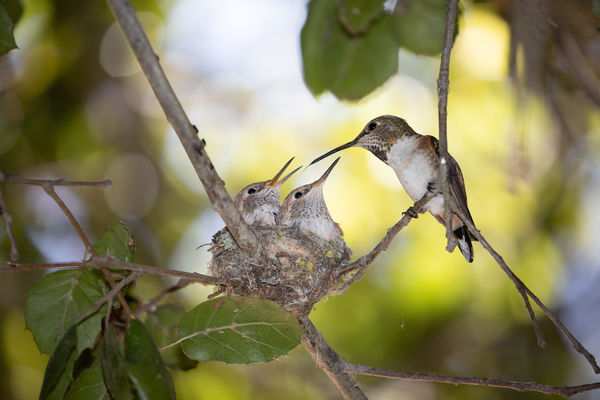
(Download)
Yes, you'll see some motion blur on the wings, but it's not a double exposure, it's simply motion blur
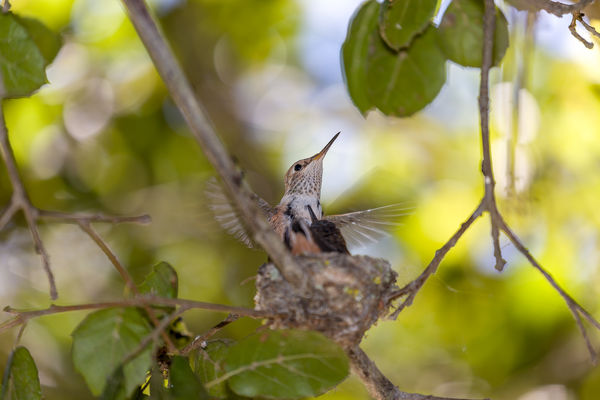
(Download)
If you want to reply, then register here. Registration is free and your account is created instantly, so you can post right away.



